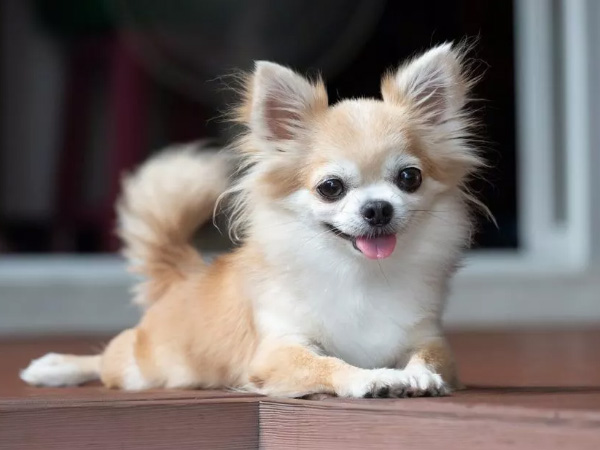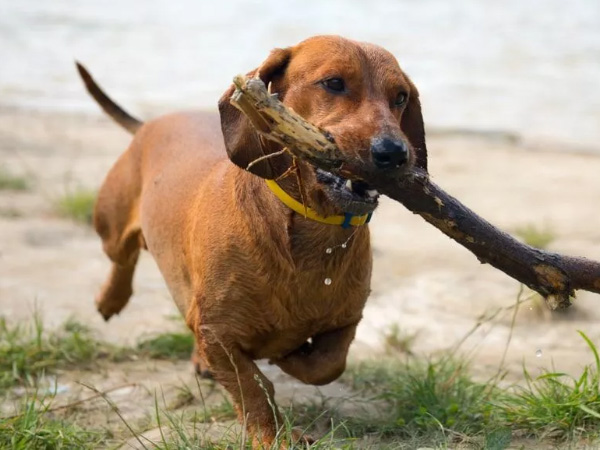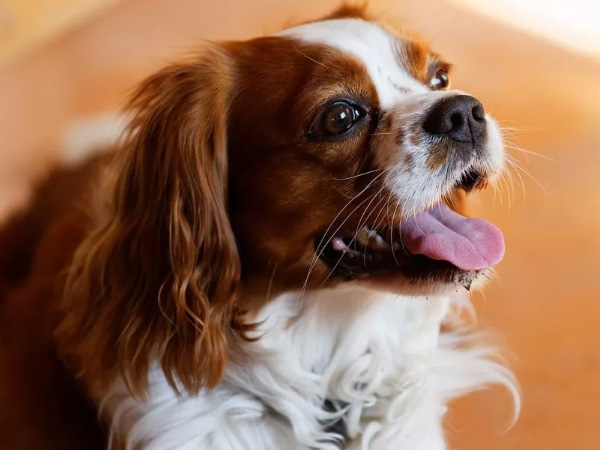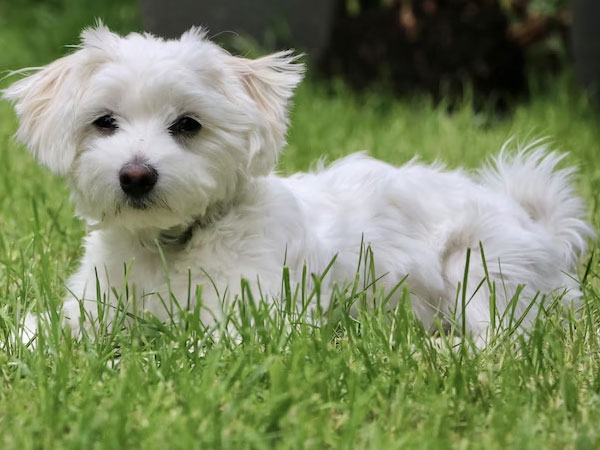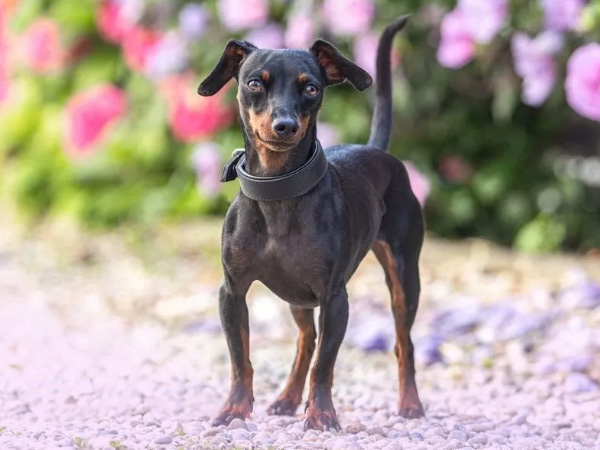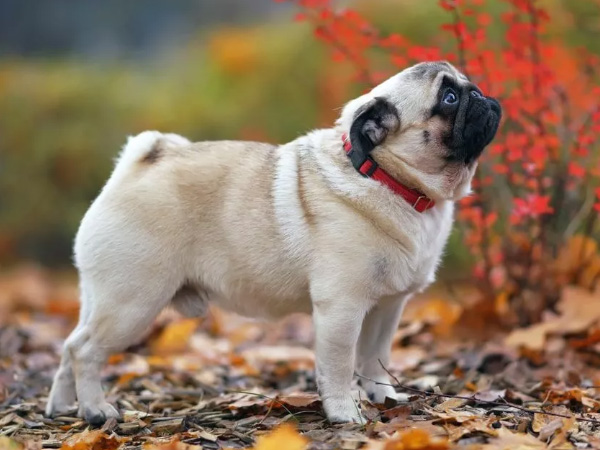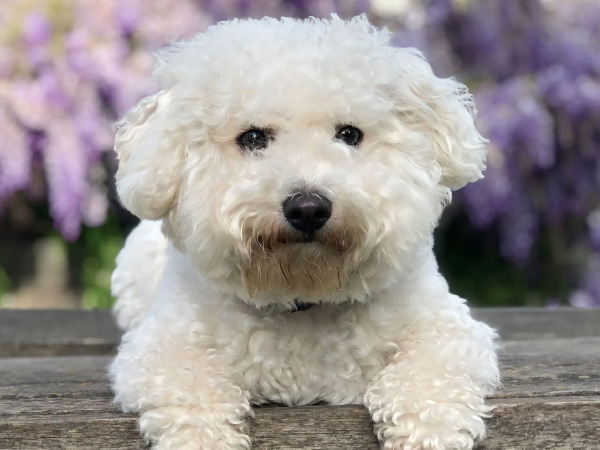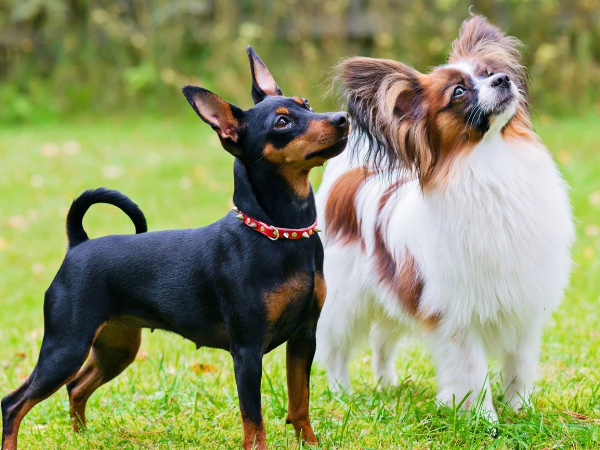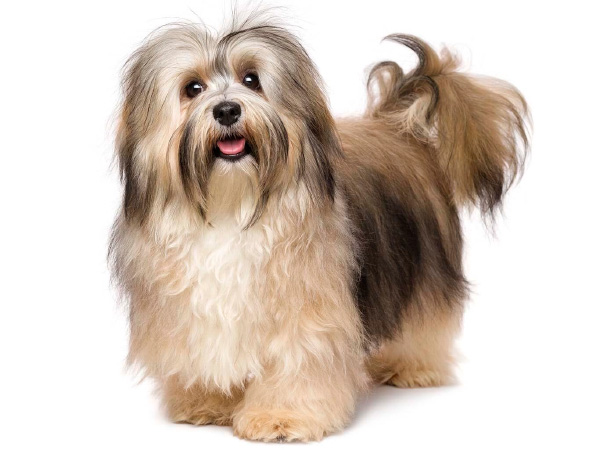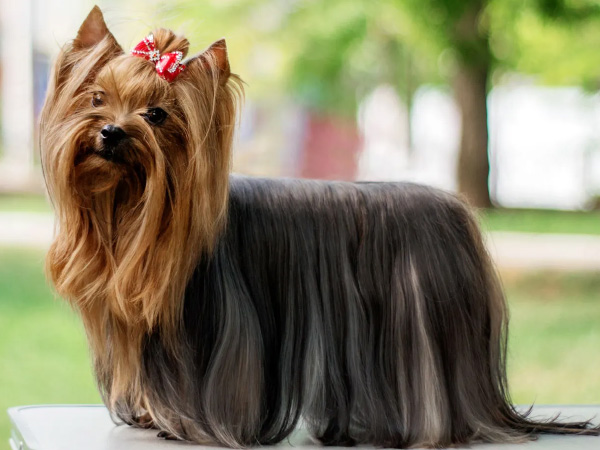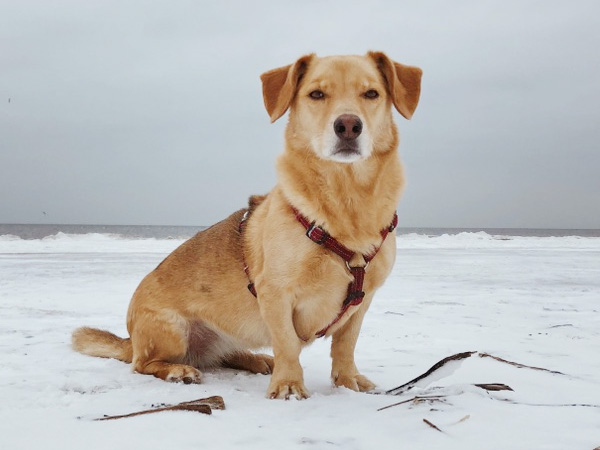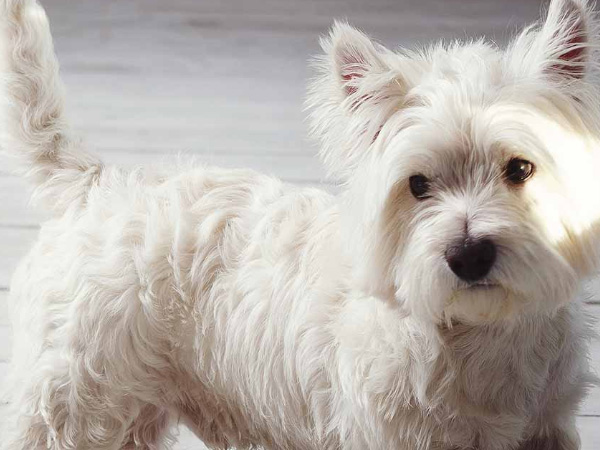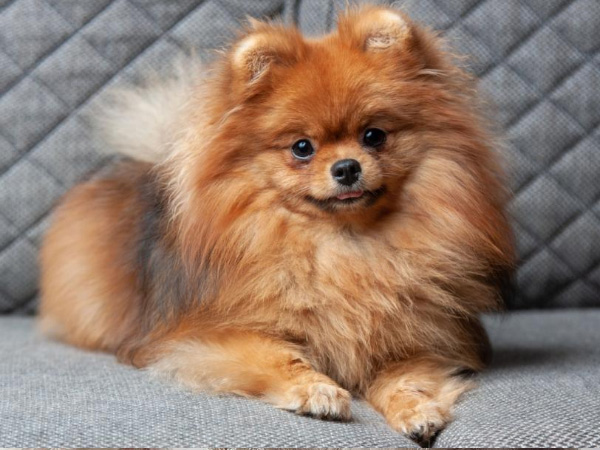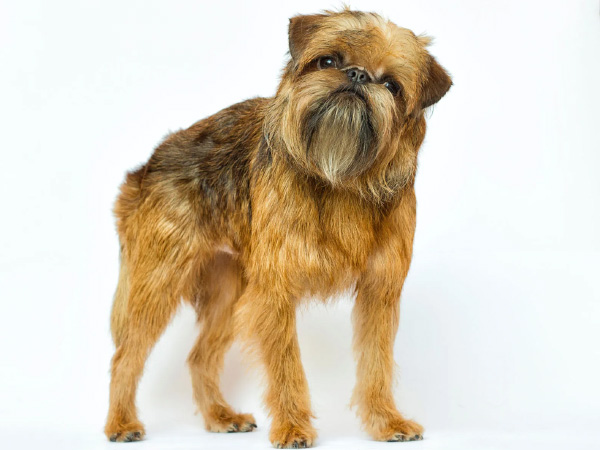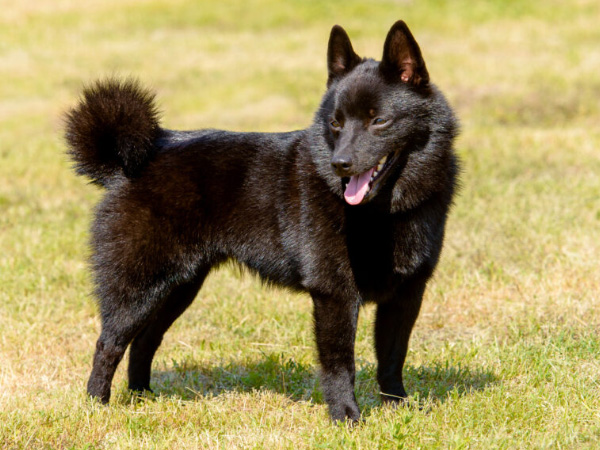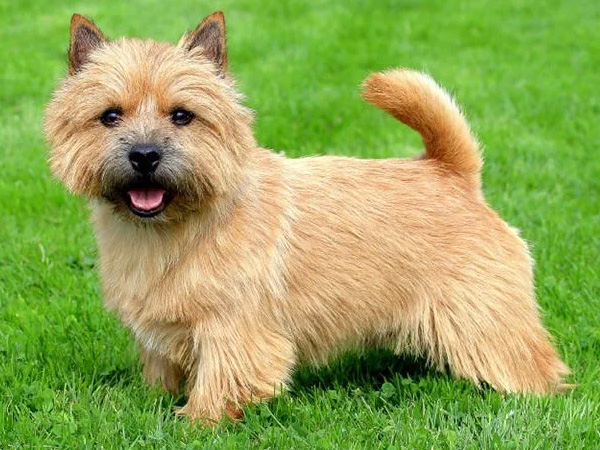This post is also available in:
Français (French)
Español (Spanish)
When selecting a miniature pup, there are numerous things to take into account.
When selecting a small breed, one must consider the various benefits and drawbacks that different breeds offer. In this blog post, we will explore the various small dog breeds and their unique qualities – from toy to terrier to hound, non-sporting to working and herding.
We will discuss the unique qualities each group possesses while highlighting their respective pros and cons. By exploring popular examples within these categories such as Yorkshire Terriers or Bichon Frises for toy dog lovers or Jack Russell Terriers for those who prefer more energetic companions.
This comprehensive guide aims to help you make an informed decision when choosing your next furry friend from among the best breed small dogs available today.
Chihuahuas, Dachshunds, and English Toy Spaniels
These popular dog breeds are known for their loyalty and energy. Chihuahuas weigh around five pounds but have huge personalities, while Dachshunds are charming with a rich history as hunting dogs in Germany. The aristocratic English Toy Spaniel can sometimes exhibit stubbornness but remains an excellent companion.
Loyal and energetic Chihuahuas
Chihuahuas, the smallest of all dog breeds, may be tiny in size but they pack a big punch when it comes to personality. They’re fiercely loyal to their favorite humans and make great companions for those who appreciate their spirited nature. Even though we can see that they’re small, don’t try telling them that they’re not a big dog. Some of them could even be said to have a Napoleon complex. They have the body of a small dog but the courage of a big dog.
Graceful Dachshunds with hunting backgrounds
The Dachshund, also known as the “wiener dog” or “sausage dog,” is another popular small breed that originated from Germany where they were originally bred for hunting badgers. Their elongated bodies and short legs give them a unique appearance that many pet parents find endearing. Despite being slightly smaller than larger dogs, these clever pups possess surprising strength which makes them good watchdogs.
Aristocratic temperament of the English Toy Spaniel
Last but not least on our list is the elegant English Toy Spaniel. This breed’s gentle nature makes it well-suited for life as a loving lapdog. With its longhaired variety and distinctive appearance, the English Toy Spaniel is sure to turn heads wherever it goes. However, pet parents should be prepared for occasional stubbornness from this small package. This stubbornness seems par for the course for toy dogs.
- Chihuahuas: Loyal, energetic, and minimal grooming required
- Dachshunds: Graceful hunters with surprising strength
- English Toy Spaniels: Aristocratic temperament and gentle nature
In choosing one of these popular small dog breeds as your next furry companion, consider their unique traits and personalities that make them stand out among other toy dogs. Whether you’re drawn to the loyal Chihuahua or the graceful Dachshund or even the aristocratic English Toy Spaniel – each breed offers something special for different pet parents’ preferences.
For centuries, these three diminutive canines have been beloved for their unwavering loyalty and spirited nature, making them ideal pets. Though they may be some of the most popular dog breeds, there are still many other breeds of small dogs that could make excellent companions.
Maltese, Miniature Pinschers, Pugs, Russian Toys, Schipperkes and Shih Tzus
These popular small dog breeds offer diverse characteristics that make them great companions. From the noble lapdog Maltese to athletic Miniature Pinschers or affectionate Pugs dating back to ancient China; each breed has unique traits perfect for different pet parents’ preferences.
Noble Lapdog Qualities of the Maltese
The Maltese is a toy breed known for its silky white coat and gentle nature. This loving lapdog thrives on human companionship and can be easily trained due to their intelligence. Their small size makes them ideal for apartment living but they still require regular grooming to maintain their beautiful appearance.
Athleticism Packed into 10-pound Miniature Pinschers
Miniature Pinschers, also known as Min-Pins, are tiny dogs with big personalities. They’re energetic, fearless and curious by nature which makes them excellent watchdogs despite their small stature. These little canines, with the correct guidance and early socialization, may become well-mannered family pets that appreciate regular walks or playtime in the backyard.
Affectionate Nature of Ancient Chinese Pugs
Pugs have been cherished pets since ancient times in China where they were bred as companion animals for royalty. These charming little dogs are characterized by their wrinkled faces and curly tails which give them a unique appearance. Pugs possess an amiable temperament and are flexible, making them a great pet for both young kids and seniors.
These small breeds are the perfect companions for those looking for a loyal and loving pet, while Bichon Frises offer an ideal combination of gentleness and playfulness that make them great cuddlers. For those seeking even more affectionate pets, Bichon Frises may be just what they need.
Bichon Frises – Perfect Cuddlers for Adults & Older Children
The Bichon Frise is a small dog breed that has become increasingly popular among pet parents who desire a loving and cuddly companion. These pooches, with their fluffy coats, big ears and coiled tails, are ideal for snuggling up to.
Hypoallergenic Properties
One of the main reasons Bichon Frises have gained popularity is due to their hypoallergenic properties. Their unique coat type does not shed as much as other breeds, making them an ideal choice for people with allergies or sensitivities to pet dander. The American Kennel Club lists the Bichon Frise as one of its top hypoallergenic dog breeds.
Gentle Nature & Affectionate Personality
These toy dog breeds tend to be favored by adults and older children because they possess a gentle nature that makes them great companions without being overly demanding or high-energy like some larger dogs. They are also known for their affectionate personality, often forming strong bonds with their favorite humans.
- Friendly disposition: Bichons get along well with both young children and older adults alike.
- Social butterflies: They enjoy meeting new people and thrive in social situations when properly introduced.
- Loving lapdogs: A common trait among these tiny dogs is their love for snuggling on laps while providing comfort through physical touch.
Potential Challenges
While Bichon Frises are generally easygoing and adaptable, they can sometimes exhibit stubbornness or be slightly more challenging to train than other small breeds. However, with patience and consistency in training methods, these loving lapdogs can become well-behaved members of the family.
In addition to their occasional stubborn streaks, it is important for pet parents to keep up with regular grooming sessions as their longhaired coats require frequent brushing and trimming. This will help prevent matting and maintain a healthy coat.
Overall, the Bichon Frise is an excellent choice for those seeking a gentle-natured dog that offers affectionate companionship while being relatively low-maintenance compared to larger dogs or high-energy small breeds like Jack Russell Terriers or Yorkshire Terriers.
Bichon Frises are the perfect cuddlers for adults and older children, as they have a gentle disposition that makes them ideal companions. However, intelligent small breeds such as Poodles, Chihuahuas & French Bulldogs require more mental stimulation to keep them entertained and active.
Intelligent Small Breeds – Poodles, Chihuahuas & French Bulldogs
While all dogs are intelligent in their own way, some small dog breeds stand out for their exceptional smarts and need for mental stimulation. Highly intelligent dogs like Poodles, Chihuahuas, and French Bulldogs require plenty of activities to stay happy while providing endless entertainment through training exercises.
High-energy requirements in intelligent small breeds
Their high energy levels make these popular small dog breeds ideal companions for pet parents who enjoy an active lifestyle. These diminutive canines may be smaller than bigger breeds, yet they’re as yet equipped for being extremely dynamic. Regular walks, playtime at the park or even agility courses can help keep your energetic pup mentally stimulated and physically fit.
Importance of mental stimulation for these dogs
Mental stimulation is just as important as physical exercise when it comes to keeping your smart little companion happy and healthy. Intelligent toy dog breeds like Poodles, Chihuahuas, and French Bulldogs thrive on learning new tricks or solving puzzles that challenge their minds.
- Puzzle toys: Interactive puzzle toys can provide hours of fun while testing your dog’s problem-solving skills.
- Obedience training: Teaching basic commands such as sit, stay or come not only helps with behavior management but also keeps your furry friend’s mind sharp.
- Trick training: Advanced tricks like rolling over, playing dead or even fetching your slippers can be a fun way to bond with your dog while keeping their brain engaged.
In addition to providing mental stimulation, these activities also help strengthen the bond between you and your pet. So, whether it’s through obedience classes or simply teaching them new tricks at home, make sure you invest time in nurturing the intelligence of these remarkable small breeds for a happier and healthier life together.
Intelligent small breeds such as poodles, chihuahuas and french bulldogs require high-energy requirements to keep their minds stimulated. The next heading will discuss the happy, loving and lovable breed of Havanese.
Havanese – The Happy, Loving & Lovable Breed
Known for their affectionate nature, the Havanese breed is unbelievably happy and lovable but can sometimes be stubborn. They make great companions while providing endless love and entertainment to pet parents who appreciate their unique qualities.
Their Origins and History
The Havanese originated in Cuba as a companion dog for wealthy families during the 18th century. As Cuban refugees migrated to the United States in the late 20th century, they brought these adorable dogs with them, making them popular small dog breeds among American pet parents today.
Socialization Skills of Havanese Dogs
- Friendly: These tiny dogs are known for being friendly towards people of all ages, including young children. Their gentle nature makes them perfect playmates for kids.
- Sociable: With proper socialization from an early age, Havanese dogs can get along well with other pets such as cats or even larger dogs.
- Loyal: This breed forms strong bonds with its favorite humans and will follow you around wherever you go.
Grooming Needs of a Havanese Dog
Havaneses have long silky coats that require regular grooming to prevent matting. Some pet parents choose to keep their fur trimmed short (known as a “puppy cut”) which reduces grooming time significantly. Regardless of coat length, it’s essential to brush your Havanase at least once a week using a slicker brush or comb designed specifically for this type of coat.
Exercise and Training Requirements
Although Havanese dogs are small in size, they still require daily exercise to maintain their health and happiness. A brisk walk or play session in the backyard will suffice for most Havaneses. They’re also intelligent dogs that enjoy learning new tricks and commands, making them easily trained with positive reinforcement techniques such as treats or praise.
Potential Health Issues
As with any breed, there are potential health issues to be aware of when owning a Havanese dog. Some common concerns include hip dysplasia, luxating patellas (slipping kneecaps), cataracts, and heart murmurs. Regular veterinary check-ups can help detect these conditions early on so your furry friend can receive proper treatment if needed.
In summary, the Havanase is an affectionate small dog breed perfect for families looking for a loving lapdog that’s great with children while providing endless entertainment through its playful antics.
The Havanese breed is known for its happy, loving and lovable personality making it a great family pet. With their playful personalities in small packages, Boston Terriers, Dachshunds & Yorkshire Terriers are the perfect addition to any home looking for an energetic companion.
Great Family Pets – Boston Terriers, Dachshunds & Yorkshire Terriers
These playful small dog breeds are perfect family pets but may require proper socialization from a young age to get along with other dogs. Their energetic personalities provide fun-loving interactions suitable for families with children.
Playful Personalities in Small Family Pets
Boston Terriers, also known as the “American Gentleman,” are friendly and affectionate companions that thrive on human interaction. They have an excellent temperament, making them great playmates for kids of all ages. Similarly, Dachshunds, despite their hunting backgrounds, possess a lively and loving nature that endears them to both adults and children alike. Last but not least, Yorkshire Terriers, or Yorkies as they’re commonly called, are tiny dogs with big personalities who enjoy playing games and spending time with their favorite humans.
- Boston Terriers: Friendly and affectionate companions.
- Dachshunds: Lively and loving nature.
- Yorkshire Terriers: Tiny size but big personality.
Playful Personalities in Small Family Pets
Boston Terriers, also known as the “American Gentleman,” are friendly and affectionate companions that thrive on human interaction. They have an excellent temperament, making them great playmates for kids of all ages. Similarly, Dachshunds, despite their hunting backgrounds, possess a lively and loving nature that endears them to both adults and children alike. Last but not least, Yorkshire Terriers, or Yorkies as they’re commonly called, are tiny dogs with big personalities who enjoy playing games and spending time with their favorite humans.
Importance of Early Socialization
To ensure these popular small dog breeds become well-rounded members of your family, it’s essential to expose them to various experiences during their formative years. This includes meeting new people (both adults and children), encountering different animals (especially larger dogs), and exploring various environments. Proper socialization will help your small dog develop confidence, reduce fearfulness, and promote positive interactions with other pets in the household or neighborhood.
In summary, Boston Terriers, Dachshunds, and Yorkshire Terriers are excellent choices for families looking to add a playful small dog breed to their home. With proper socialization from an early age, these energetic companions can become beloved members of any family unit.
Boston Terriers, Dachshunds and Yorkshire Terriers are great family pets that bring a lot of fun to the home. With their playful personalities, these small dogs make wonderful companions for any household. Corgis have become increasingly popular due to their bright dispositions and ease of training; they are sure to be an excellent addition to your family.
Corgis – Bright Disposition & Easy Training
One of the most popular small dog breeds, Corgis are particularly good with children thanks to their bright disposition. They’re also very easy to train because of their intelligence combined alongside willingness-to-please attitudes. This makes them an excellent choice for families looking for a trainable and friendly small dog breed.
Intelligent and Eager to Learn
Corgis have been ranked among the smartest dog breeds, making them highly responsive to training. Their eagerness to learn new commands and tricks ensures that they can be trained quickly, which is ideal for busy pet parents who want a well-behaved companion without spending too much time on training sessions.
Socialization is Key
As with any breed, it’s essential to start socializing your Corgi from a young age. Introducing them early on to different people, environments, sounds, and other animals will help ensure they grow up confident and adaptable in various situations. Proper socialization will also prevent potential behavioral issues such as aggression or fearfulness towards strangers or other dogs.
- Enroll in puppy classes: Puppy classes provide an excellent opportunity for your Corgi pup not only to learn basic obedience but also interact with other puppies under controlled conditions.
- Puppy playdates: Arrange playdates with friends’ dogs or neighbors so that your Corgi gets used interacting positively with different types of dogs.
- Daily walks: Taking daily walks exposes your Corgi pup various sights, sounds, and smells in the neighborhood, helping them become more comfortable with their surroundings.
Positive Reinforcement Training Techniques
When training your Corgi, it’s essential to use positive reinforcement techniques. This means rewarding good behavior with treats, praise or playtime while ignoring unwanted behaviors. Punishing or scolding a dog for bad behavior can lead to fear and anxiety which may hinder the learning process. Consistency is also crucial; make sure all family members follow the same rules when interacting with your Corgi to avoid confusion.
In conclusion, with their bright disposition and easy trainability, Corgis make excellent companions for families looking for a small dog breed that is both intelligent and friendly. Remember to start socialization early on and use positive reinforcement techniques during training sessions to ensure you have a well-behaved furry friend who will bring joy into your home.
Corgis are an ideal breed for novice owners due to their easy-to-train and friendly dispositions. Westies require a good amount of physical activity outdoors to stay content and in shape.
Westies (West Highland White Terriers) – High-Energy Levels & Outdoor Activities
The West Highland White Terrier, affectionately known as the Westie, is a small dog breed that boasts high-energy levels and an undeniable love for outdoor activities. Despite their tiny size, these dogs are always ready to play and explore.
Energy That Needs Channeling
One of the most notable characteristics of Westies is their seemingly endless energy. Pet owners must make sure to give their Westies adequate exercise in order to keep them content and healthy. A few ways pet parents can help channel this energy include:
- Taking them on daily walks or runs
- Engaging in interactive games like fetch or tug-of-war
- Scheduling regular playdates with other dogs at a local dog park
- Incorporating agility training into their exercise routine
A Love for Digging Holes & Chasing Prey
Bred originally as hunting dogs in Scotland, Westies have retained some instincts from their ancestors such as digging holes and chasing after anything that moves. Pet parents should be prepared to manage these behaviors by providing ample opportunities for safe digging areas like sandboxes or designating specific spots in the yard where they can dig without causing damage.
An Ideal Environment: Spacious Outdoors & Proper Supervision Indoors
To accommodate your energetic Westie’s needs, it’s essential to provide enough space outdoors where they can burn off excess energy without wreaking havoc inside your home. If you live in an apartment or don’t have access to a large backyard, consider taking your Westie to a nearby park or open space where they can run and play freely.
When indoors, proper supervision is necessary to ensure your Westie doesn’t get into mischief. Providing them with plenty of toys and mental stimulation will help keep them entertained while you’re at home together.
The Importance of Socialization & Training
Westies are known for their strong-willed personalities, which can sometimes make training more challenging than with other small dog breeds. However, early socialization and consistent positive reinforcement-based training methods will go a long way in shaping well-behaved companions that enjoy interacting with both humans and other dogs alike.
In conclusion, Westies are highly energetic dogs that love outdoor activities, making them an ideal choice for active families. Pomeranians may look quiet and demure on the outside, but don’t let their appearance fool you; they have intense curiosity and a strong desire to explore.
Pomeranians – Quiet Appearance But Intense Curiosity
Pomeranians, also known as Pom-Poms, are small dog breeds that might appear quiet at first glance yet underneath those sweet faces lies an intense curiosity about the world around them. Don’t let these little guys fool you into thinking they won’t get up to mischief when left alone too long; keeping them entertained will ensure a well-behaved companion.
The Inquisitive Nature of Pomeranians
These tiny dogs have a natural inclination to explore their surroundings and investigate anything new or unusual. This inquisitiveness can sometimes lead to trouble if not properly supervised, so it’s essential for pet parents to keep an eye on their Pom and provide appropriate toys and activities that cater to this innate curiosity.
- Interactive Toys: Provide your Pomeranian with puzzle toys, treat-dispensing balls, or other interactive playthings that stimulate their minds while satisfying their need for exploration.
- Obedience Training: Enroll your Pom in obedience classes or teach them tricks at home using positive reinforcement techniques. Socializing your Pomeranian early on is key for building confidence and preventing any behavioural issues, while also helping to foster the connection between you two.
- Socialization: Expose your Pomeranian early on to various environments, people, animals, sounds – this helps develop confidence while curbing any potential behavioral issues stemming from fear or anxiety.
Mischievous Behavior & How To Manage It
Pet parents should be aware of some common mischievous behaviors exhibited by Pomeranians, such as chewing on furniture or stealing items. Here are some tips to manage these behaviors:
- Provide Chew Toys: Offer your Pom a variety of safe and appropriate chew toys to redirect their need for gnawing away from household objects.
- Puppy-Proof Your Home: Keep valuable or dangerous items out of reach, secure trash cans, and use baby gates if necessary to prevent access to off-limits areas.
- Consistent Training & Boundaries: Establish clear rules and boundaries for your Pomeranian while reinforcing good behavior with praise and rewards.
In addition to managing mischief, it’s essential that pet parents also address any potential health concerns specific to the breed. For example, Pomeranians are prone to dental issues due in part because of their small size; regular teeth cleanings by a veterinarian can help maintain oral hygiene and overall well-being
A Lovable Companion Despite Their Mischievous Side
Their curiosity might lead them into trouble at times but ultimately makes life with a Pomeranian all the more entertaining. With proper care, training, socialization – these tiny dogs make loving lapdogs who will bring joy into any home they join.
Pomeranians may have a quiet appearance, but their intense curiosity and playful nature make them an excellent companion for any dog lover. Schipperke’s are known for their mischievous personality, which can be both endearing and exasperating in equal measure.
Brussels Griffons
The Brussels Griffon is a small dog breed that has captured the hearts of many dog lovers around the world. With their adorable faces, charming personalities, and unique appearance, it’s no wonder why they are becoming more and more popular as a companion animal.
Here are some reasons why the Brussels Griffon is a wonderful small dog breed:
They are adorable.
Brussels Griffons are one of the most visually distinctive small dog breeds, thanks to their adorable faces and expressive eyes. They come in a variety of colors, including red, black, and beige, and their shaggy fur and wiry whiskers only add to their charm.
They are loyal.
Brussels Griffons are incredibly loyal to their owners and make excellent companion animals. They thrive on human interaction and love nothing more than spending time with their family. They are also very protective of their owners and will do whatever it takes to keep them safe.
They are intelligent.
Brussels Griffons are a highly intelligent breed and are known for their ability to learn quickly. They are eager to please their owners and enjoy training sessions. This intelligence also means that they can become bored easily, so it’s important to keep them mentally stimulated with games and puzzles.
They are adaptable.
Despite their small size, Brussels Griffons are very adaptable and can thrive in a variety of living situations. They are happy in small apartments, as long as they get enough exercise and attention. They are also great travel companions, and their small size makes them easy to take with you wherever you go.
They have a unique personality.
Brussels Griffons are known for their quirky personalities, and each dog has its own unique traits and quirks. They are playful and affectionate, but also have a stubborn streak that can be both endearing and challenging. They are great at reading their owner’s emotions and can be very empathetic.
Schipperke’s Mischievous Nature
The Schipperke is one curious breed; lively by nature yet equally capable of becoming intensely focused on whatever task lies before it. These mischievous creatures will keep you entertained every day while still providing unconditional love throughout life together as pet owners.
Lively and Curious Personality
Schipperkes are known for their spirited, inquisitive personalities that make them great companions for those who enjoy an active lifestyle. Their curiosity often leads them to explore new environments and engage with various stimuli, making each day a fun adventure with this small dog breed.
Intense Focus on Tasks at Hand
Despite their playful demeanor, Schipperkes can become incredibly focused when presented with a task or challenge. This trait makes them excellent candidates for activities such as agility training, obedience competitions, or even working as therapy dogs due to their ability to concentrate on the job at hand while remaining calm under pressure
Mischievous Behaviors Require Consistent Training
- Boredom: A bored Schipperke may resort to destructive behaviors like chewing furniture or digging holes in your yard if not provided with enough mental stimulation and physical exercise daily.
- Escape Artist: With their intelligence and agility, these small dogs are known to be skilled escape artists. Pet parents should invest in a secure fence and keep an eye on their Schipperke during outdoor activities.
- Stubbornness: While they can be easily trained, some Schipperkes may exhibit stubborn tendencies that require patience and consistency from pet parents when teaching new commands or correcting unwanted behaviors.
In order to curb these mischievous behaviors, it’s essential for pet parents to provide consistent training and plenty of mental stimulation through puzzle toys, interactive games, or even dog sports like agility or flyball. By keeping your Schipperke engaged both mentally and physically, you’ll have a well-behaved companion who brings endless joy into your life.
The Schipperke is an incredibly mischievous breed, but with proper training and socialization they can make a great companion. Despite their small size, there are still some drawbacks to owning a smaller dog that should be considered before adoption.
Disadvantages of Small Dog Breeds
Despite the many benefits of owning a small breed dog, potential health issues, fragility due to their size and difficulties in training or socializing with larger dogs must be taken into consideration. Pet parents should be aware of these drawbacks when choosing a small breed dog.
Health concerns specific to small breeds
Small dog breeds often face unique health problems that may not affect larger dogs. For example, they can suffer from dental issues due to overcrowding in their mouths or develop patellar luxation, which is a dislocation of the kneecap common among toy breeds like Yorkshire Terriers and Pomeranians. Additionally, some popular small dog breeds like French Bulldogs and Boston Terriers are prone to breathing difficulties because of their flat faces (Brachycephalic Syndrome). Regular veterinary check-ups can help detect any potential health issues early on.
Fragility and vulnerability around larger dogs
Their tiny size makes them more vulnerable than large dogs in certain situations. They might easily get injured if accidentally stepped on or played too roughly by children or other pets. Moreover, smaller dogs may become targets for aggressive behavior from bigger animals while out walking or at the park; hence it’s essential for pet parents always to keep an eye on them during interactions with other animals.
Tips:
- Teach young children how to handle your small dog gently and with care.
- Always supervise playtime between your small dog and larger dogs, especially if the size difference is significant.
- Consider enrolling your small dog in a specialized training class or socialization group specifically designed for smaller breeds to ensure their safety and comfort around other animals.
Training and socialization challenges
Small dogs can sometimes be more challenging to train than their larger counterparts. They may exhibit stubbornness or develop what’s known as “small dog syndrome,” where they display dominant behavior due to being overly pampered by their owners. Toy breeds like Chihuahuas, if not trained and socialized from an early age, may become territorial and aggressive towards strangers or other pets.
To avoid these issues:
1. Start obedience training at a young age using positive reinforcement techniques such as treats, praise, and toys as rewards for good behavior.
2. Socialize your small breed puppy with various people, environments, sights, sounds while ensuring that each experience is positive so that they grow up well-adjusted adults who feel comfortable in different situations……
Conclusion
It is clear that following the conventions of proper HTML format is essential for successful web development. It’s important to note that headers should not be added and the output must not exceed 100 words. By adhering to the aforementioned rules, developers can create websites that are easy for all users to navigate and use. In addition, it’s essential to avoid using “In conclusion” or “In summary” when writing conclusions as they sound repetitive and unprofessional. Instead, opt for a concise yet informative wrap-up of your content. To take action on this knowledge, Project encourages all developers to review their website code and ensure compliance with proper HTML formatting rules. This will improve site accessibility and enhance user experience significantly.
If you are looking for a small dog to adopt, consider supporting Bone Voyage Dog Rescue and help them find forever homes for these rescued Mexican dogs. By donating or volunteering your time, you can make an impact in the lives of these animals and their adoptive families.
Frequently Asked Questions Best Breed Small Dogs
What is the #1 small dog breed?
The top small dog breed varies depending on individual preferences and needs. However, one popular choice among pet owners is the Toy Poodle due to its intelligence, hypoallergenic coat, and friendly nature. Other notable options include Cavalier King Charles Spaniels and French Bulldogs.
What is the best small family dog to have?
The best small family dog depends on your household’s specific requirements. The Cavalier King Charles Spaniel is a great option for families with children due to their affectionate and adaptable nature. Other excellent choices are Beagles or Miniature Schnauzers.
What is the cutest small dog in the world?
Cuteness can be subjective; however, many people find breeds like Pomeranians, Shih Tzus, or Bichon Frises exceptionally adorable because of their fluffy coats and expressive faces. Ultimately, what you consider cute will depend on personal preference.

